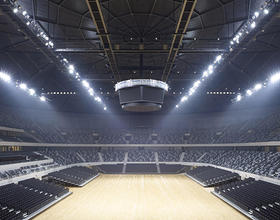UNIVERSIADE SPORTS CENTER
-
The new city district offers various sports facilities, residential areas, and leisure and shopping facilities. Both the sports venues – the stadium, multifunctional hall and swimming hall – and the urban areas blend with the landscape at the foot of Mount Tong Gu Ling in the centre of the region.
The design is inspired by the surrounding undulating landscape. This enables topographical modulation in the sports center area, with flows of people on various levels. An artificial lake connects the stadium at the foot of the mountain with the circular multifunctional hall in the north and the rectangular swimming hall west thereof. The central sports plaza is accessed via a raised promenade from the individual stadia. Two 150 m tall buildings forming the service centre round off the sports complex in the north.
The overall complex is laid out as an extensive landscaped park with typical elements of a traditional Chinese garden. Watercourses and plants symbolize movement and development, while crystalline structures in the form of stones and rocks represent continuity and stability. The dialogue between the fluid landscape shapes and the expressive architecture of the stadia constitutes the conceptual framework of the design. The crystalline shape of the three stadia is additionally emphasized by the illumination of the translucent facades at night.
The main stadium is planned to be multifunctional, meeting the requirements of local, national and international sports occasions and events. Total capacity is 60,000, seated in three stands. The middle tier on the western side includes a 200-seat VIP stand with attached dignitaries’ boxes. Between the middle and upper tier there are 60 VIP boxes with their associated seating. All technical facilities required by participants and other functional areas are accommodated at field level beneath the stands. Guests of honor and media representatives can meet up here in the socializing zone provided. Access routes for individual user groups do not conflict. The sports plaza serves as the main access level for spectators. Access to the lower tier and steps to the middle and upper tiers alternate with kiosks and sanitary facilities. The broad passageways allow attractive glimpses into the circular shape of the stadium from afar, and make for easy orientation. The curved upper tier is accessed via twelve broad staircases leading off the circulating area, which allow impressive glimpses of the roof structure and the other stadia. The upper tier is divided into two parts, and as it is almost a circle, is doubly curved. In this way, the stadium has an exciting shape both on the inside and seen from outside.
The roof structure projects up to 65 m, and is designed as a steel prismatic shell on a basis of triangular facets. The total diameter of the roof is 310 m lengthways and 290 m across. Both roof and façade have three layers each. The external façade layer is translucent glazing made up of triangular laminated safety glass panes or polycarbonate slabs. The interior membrane layer, likewise translucent, fulfils the requirements for shade and acoustics, and acts as a reflecting surface for the façade illumination. The folded primary and secondary steel structure is located in between. The major part of the technical installations is also integrated into this area.
The indoor sports complex is designed as a circular multifunctional arena for indoor sports competitions as well as for ice-skating, mega-performances, social gathering and small-scale exhibition shows. The overall capacity is approx. 18,000 spectators. The seats are arranged on two stands, the first rows of the lower stand with a total number of 3,000 seats are movable. The seating organization is laid out for optimal viewing as well as for even circulation and distribution of the people. The arena offers supreme viewing conditions in all areas.
The swimming complex forms the third important module of the Shenzhen Universiade Sports Centre. Its architectural design takes into account the functional requirements of this type of building as well the overall architectural appearance of the crystalline volumes in the park. The overall capacity is approx. 3,000 spectators, the seats are arranged on two stands. The swimming complex is clearly divided into a competition and a leisure swimming area.
Photo credits: Gmp Architekten, Christian Gahl
1870 Projects
















